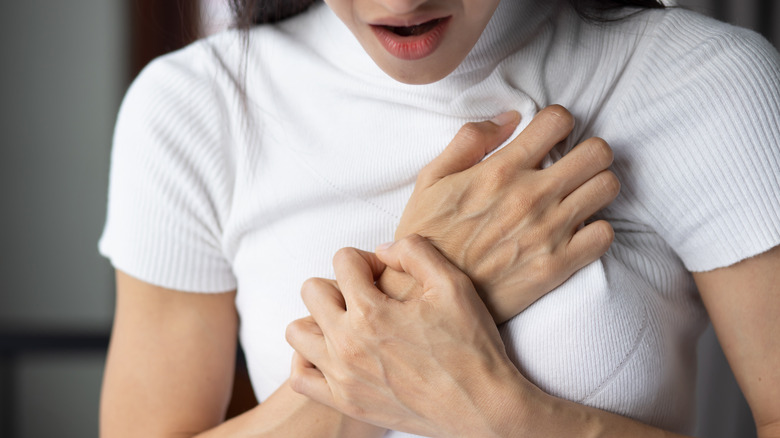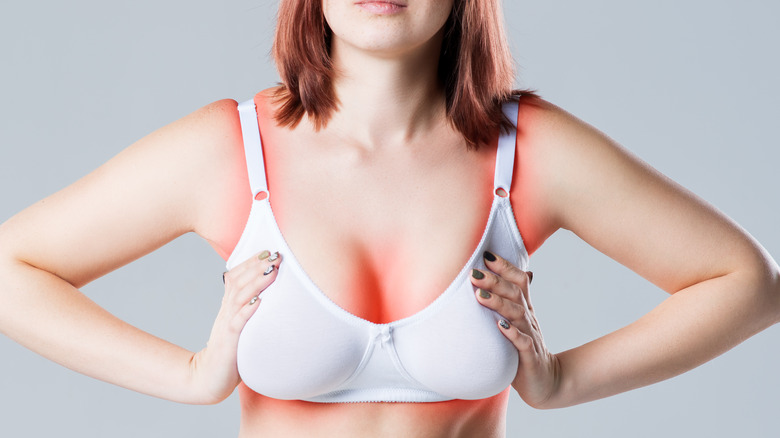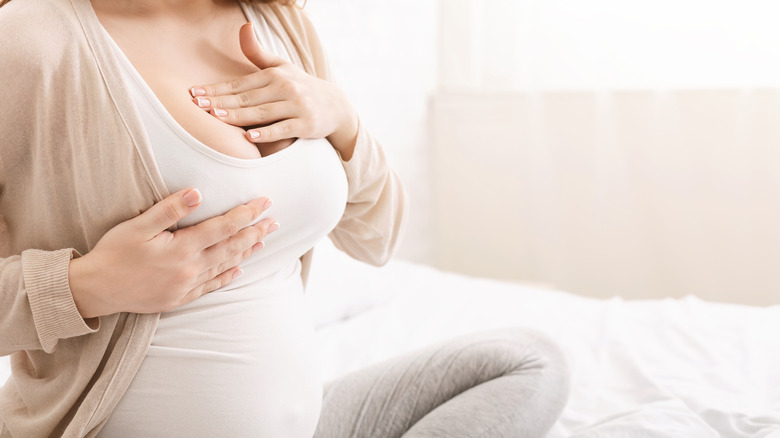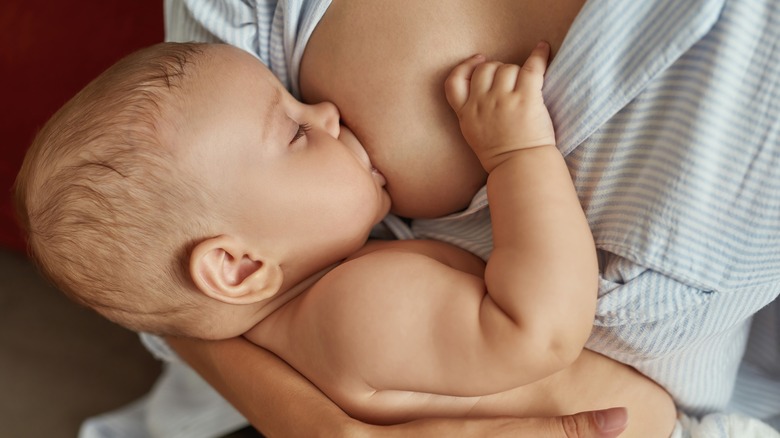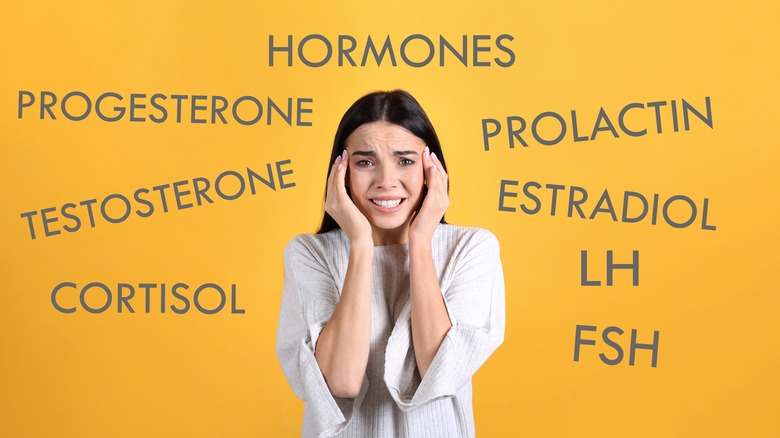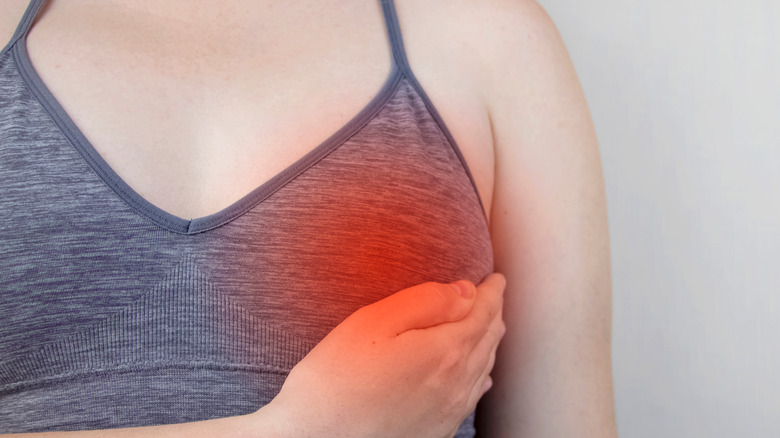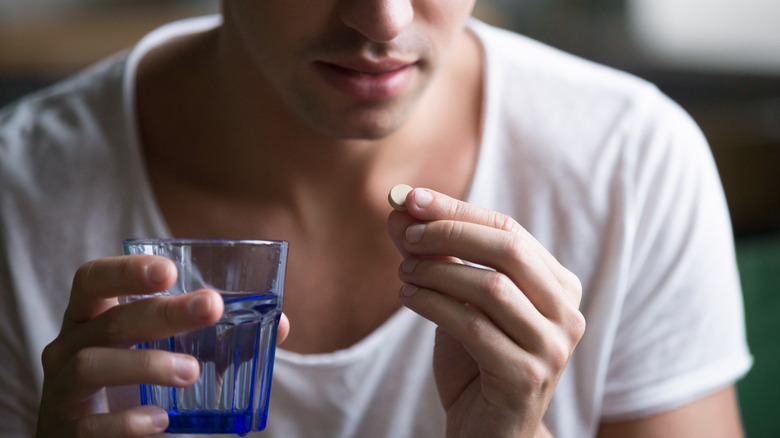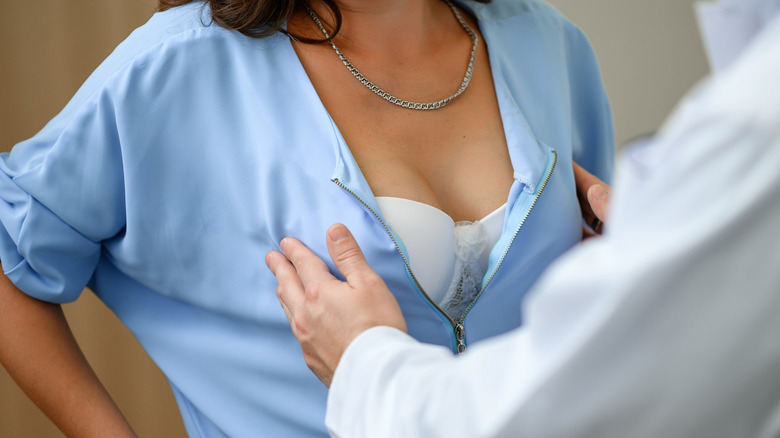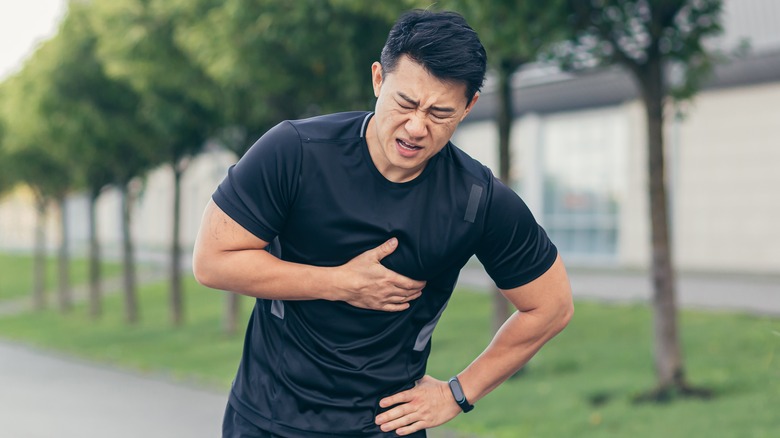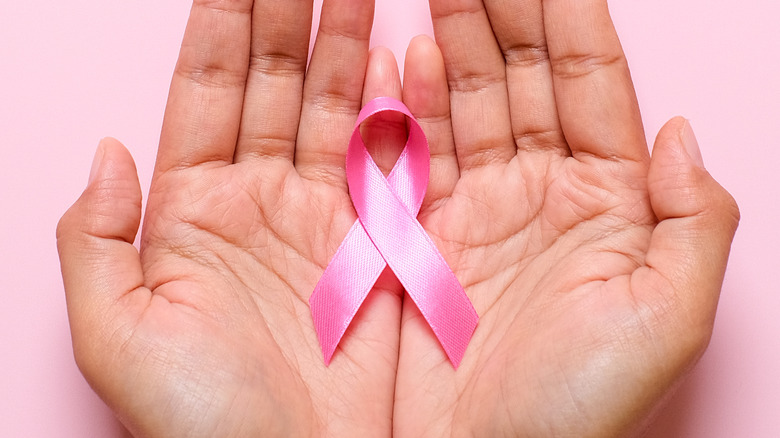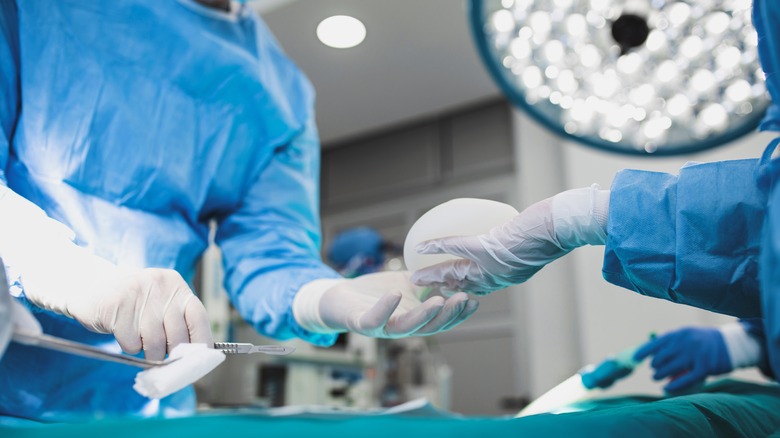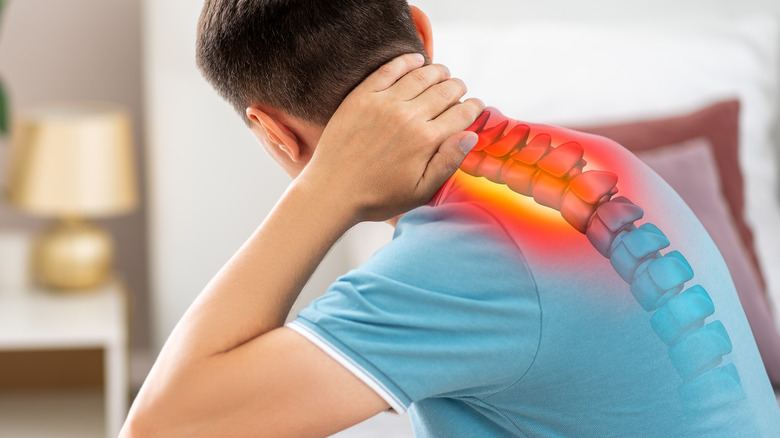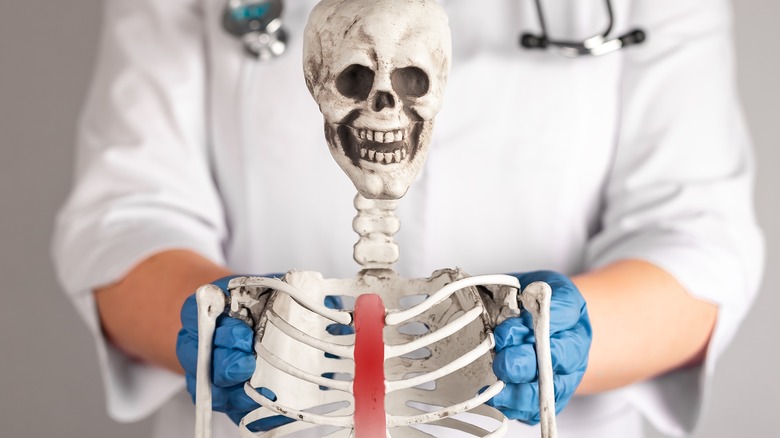Unexpected Reasons You Have Sore Breasts
Breast pain (or mastalgia) is a common condition that affects many people. However, it is more common in people assigned female at birth, impacting about two-thirds of the said population during their reproductive years (via StatPearls). Breast pain can range from mild discomfort to severe and disabling pain, it can be either constant or intermittent, and both internal and external factors can cause it.
Cyclic breast pain is linked to hormone variations characteristic of the menstrual cycle, usually occurring one to two weeks before menstruation and declining after the start of the period. It may come with additional symptoms like breast tenderness, swelling, and lumpiness. Meanwhile, non-cyclic breast pain has nothing to do with hormonal changes, and may be caused by numerous reasons (e.g., injury, infection, other breast conditions, medications). It is described as a sharp pain that can affect a specific breast area. Lastly, extramammary pain originates somewhere else in the body but feels as if it comes from the breasts.
While breast pain is rarely a sign of breast cancer, it is important to seek medical attention if it doesn't go away or doesn't improve after taking painkillers, you feel a lump or mass in the breast or armpit (especially if it doesn't go away after your menstrual cycle), you experience nipple discharge or retraction, or if you notice any changes in the breast skin, such as dimpling or puckering. Here are some unexpected reasons that may lead to breast pain and how to treat them.
You have an ill-fitting bra or chest binder
When it comes to bras, keep in mind that they're designed to support your girls. Thus, wearing a bra that is too tight can compress or squeeze them, while a bra that is too loose allows your breasts to move around excessively. Either way, you'll most likely end up with chronic breast pain and maybe even shoulder and back pain, too. Whether you're wearing an everyday bra, sports bra, or bralette, avoiding the ones that don't fit properly can significantly help reduce breast pain (yes, even if they're cute). In fact, up to 70% of people report feeling less discomfort simply by switching to an adequately fitted bra (via StatPearls). When choosing a bra, avoid going for ones with bands, cups, or straps that are too tight, too small, too large, or too loose. Also, be mindful of how the underwire fits, and ditch those that dig into the breast tissue.
Chest binders are a type of undergarment worn by people who wish to flatten their chest. However, by putting pressure on the breasts, they can cause several side effects (like shortness of breath and rubbing or chafing against the skin) that can lead to breast pain, irritation, and soreness (via Healthline). Luckily, you can easily resolve the pain by finding a binder that fits properly or taking breaks from wearing it. Prioritize your comfort and well-being when choosing a bra or binder, as prolonged discomfort can have a negative impact on your overall health and quality of life.
You're pregnant
While many people realize they're pregnant when they miss a period or two, others may start to notice pregnancy symptoms way before that, and, as it happens, having sore breasts is a common early sign of pregnancy. In fact, per the National Institute of Child Health and Human Development, sore and swollen breasts or nipples may occur as early as two weeks after conception, and it is caused by both hormonal and physical changes in the body.
As a 2020 article published in the Journal of Breast Imaging explains, pregnancy is accompanied by a significant increase in hormone levels, namely estrogen and progesterone. These hormones prompt the breast tissue to prepare for breastfeeding, which can cause the breasts to become more sensitive and more prone to pain. At the same time, these hormonal changes also cause the milk ducts and glands to enlarge, increasing breast tissue volume and leading to physical changes such as larger breasts. Thus, with pregnancy come feelings of heaviness or fullness that add up to the soreness and pain in the breast tissue.
You're breastfeeding
According to La Leche League International, breastfeeding shouldn't be a painful experience. However, it can cause breast pain due to numerous reasons, including breast engorgement, an improper latch from your baby, or even teething when breastfeeding older babies. Per a review published in the Cochrane Library, breast engorgement is a common cause of breast pain during the early weeks after delivery. It happens due to excess milk in the breasts, which can occur due to restricted breastfeeding time, mother-baby separation, or any other circumstance that leads to an inadequate emptying of the breasts. When it comes to an improper latch (meaning that the baby isn't attached correctly to the breast while breastfeeding), the Office on Women's Health explains that breast pain from a shallow latch can be caused due to sore, cracked, and bleeding nipples.
Aside from the previously mentioned causes for sore breasts during breastfeeding, other potential reasons may include an obstructed milk duct, ankyloglossia or tongue-tie of the newborn (when the baby's tongue is stuck to the bottom of the mouth, which keeps him from latching correctly), and breastfeeding-led infections like mastitis or candidiasis, per an article published in the Journal of Breast Imaging. According to the article, common treatments for sore breasts caused by breastfeeding include topical creams, hot or cold packs, or pain relievers when there's an infection.
You're going through hormonal changes
If you're going through hormonal changes that include fluctuation in the sex hormones estrogen and progesterone (e.g., those that happen during the menstrual cycle, premenstrual syndrome (PMS), or perimenopause), then you're very likely to experience sore breasts.
PMS is a group of symptoms that occur in the days or weeks leading to menstruation. During this time, breast pain may be accompanied by other symptoms such as bloating, fatigue, and mood changes. Per Medical News Today, the exact cause of PMS is not fully understood, but the rise and fall in hormone levels, along with lymph node swelling, are what causes this cyclical breast pain. The pain may be felt in one or both breasts and can range from mild to severe. Luckily, it resolves after menstruation.
While menopause is regarded as a time of intense hormonal changes due to a reduction in estrogen levels, an article published in the Journal of Breast Imaging states that it is actually during perimenopause that people may experience breast pain. Perimenopause is a transitional phase that happens before menopause, when some of the changes from menopause begin to happen, yet the menstrual period hasn't disappeared. The hormonal changes in this phase may lead to mild to extreme breast pain. Yet, once again, it decreases after menopause. Lastly, gender reassignment therapy, which involves the use of hormones to permanently transition to a different gender, can also cause breast pain (namely in transgender women) due to the changes leading to breast tissue development.
You may have a breast infection
Having a breast infection can definitely lead to breast pain and soreness. While they are more common in people who are breastfeeding, breast infections are not limited to them. One of the most common infections is mastitis, caused by bacteria entering the breast through a cracked or sore nipple. Per Johns Hopkins Medicine, mastitis can lead to breast pain, swelling, warm or hot lumps, redness, and a fever. The breast pain may be severe and can be accompanied by flu-like symptoms such as chills, fatigue, and body aches. Treatment usually involves painkillers and antibiotics, per your doctor's recommendations.
Another not-so-common breast infection linked (but not limited) to breastfeeding is a subareolar breast abscess. According to Healthline, this is an accumulation of pus in the breast tissue due to a nipple piercing, smoking, obesity, diabetes, or a mastitis complication. It can lead to breast pain, swelling, redness, and a fever. In severe cases, it may lead to a wound called a fistula or a nipple inversion (when the nipple is drawn inwards). Treatment for a breast abscess usually involves draining the pus or taking antibiotics.
Lastly, ductal ectasia can also lead to breast pain by causing the milk ducts to become clogged. It is actually a risk factor for breast infection that's most common in women nearing menopause, and can cause breast pain, nipple discharge, and a lump or thickening in the breast tissue (via Healthline). Treatment options include warm compresses or massages to help clear the ducts.
Your chest muscles are sore
Your chest muscles can become sore as a result of physical activity, which can be either an expected outcome from exercise or an unwanted injury from overuse (like a strained or pulled muscle). Nevertheless, these two different types of soreness call for different solutions.
On one hand, you'd expect to feel mild soreness in your chest (which can also feel like sore breasts) after working out your pectoral muscles (or pecs). It is caused by the physical stress your muscles went through during the workout, and may last up to two days after your gym session due to a phenomenon called delayed onset muscle soreness (DOMS), which happens when your body is getting used to a new fitness routine (via WebMD). This type of pain can be either dull or sharp and intense, and its treatment usually involves rest, ice, and pain relief medication to manage the pain.
On the other hand, breast pain due to a strain or pulled chest muscle happens when the muscle fibers get torn, either due to a specific or acute injury such as a fall or because you lifted a heavy object or because of a chronic or repetitive activity like rowing or a job-related movement (via Healthline). In this case, the treatment depends on the degree of the injury. It may range from taking a break from the activity that caused the strain and applying cold packs to your chest to requiring physical therapy sessions or even surgery.
You're experiencing a medication side effect
As you probably know, medications tend to come with a long list of potential side effects, and in some cases, breast pain can be one of them. According to an article published in the Journal of Breast Imaging, hormonal medications like birth control pills or the vaginal ring (a non-oral contraceptive) can cause breast tenderness as a side effect due to changes in the levels of estrogen and progesterone in the body. The higher the estrogen dose provided by a contraceptive method, the higher the likelihood of experiencing breast pain.
Other medications that may have breast pain as a potential side effect includw antidepressants and antipsychotic drugs such as selective serotonin reuptake inhibitors (SSRIs), amitriptyline, and haloperidol, as well as antimicrobial agents. Also, the National Breast Cancer Foundation lists blood pressure medications like methyldopa (Aldomet) and spironolactone (Aldactone) as known triggers for breast pain, alongside some diuretics and the anabolic steroid Anadrol.
Generally speaking, treating breast pain caused by medications may involve switching to a different type of medication or adjusting its dosage. However, be sure to talk to your healthcare provider before making any changes, as they can better determine the cause of your breast pain and provide appropriate treatment or management strategies.
You have a breast cyst
Breast cysts are fluid-filled sacs that can develop in the breast tissue, and while they are benign or non-cancerous, they can be both asymptomatic or appear in the form of painful lumps and nipple discharge (via StatPearls). They are extremely common, affecting up to 70% of people assigned women at birth worldwide. In addition, they're actually part of a larger non-cancerous disease called fibrocystic disease of the breast.
Fibrocystic breast changes can sometimes cause breast pain, especially around the time of the menstrual cycle (meaning that they are a type of cyclical breast pain). Since the cysts are benign, they don't need anti-cancer treatment. In fact, while the pain and lumps are a common cause of concern, neither the cysts nor the fibrocystic disease are risk factors for breast cancer. However, in the rare case of a malignant or cancerous cyst, treatment would require surgery and additional treatment options, such as chemo-, radio-, or immunotherapy.
You have a breast injury
A breast or chest injury can lead to sore and painful breasts. According to Medical News Today, the most common causes of breast injury include a sports injury, assault or a blow to the chest, a bad fall, or a car crash. In the case of the latter, pain may be caused either by protective devices like the seatbelt or airbag or by hitting the steering wheel or dashboard upon impact.
Dealing with a breast injury or trauma can result in different types of pain. Depending on what caused it, the pain can range from a dull ache to an intense, stabbing pain, and may be felt in one or both breasts. Oftentimes, it may also be accompanied by other symptoms, such as bruising or swelling. Furthermore, while breast surgery is a programmed and controlled event, it is also a type of trauma to the breast and, thus, can also lead to breast pain (via Healthline).
Treatment for breast pain caused by an injury largely depends on the type and severity of the injury. Mild injuries may not require any treatment and may resolve in time at home with the help of hot or cold compresses and a supportive bra (per Healthline). Nevertheless, more severe injuries may need to be evaluated by a healthcare provider. If you are experiencing breast pain as a result of breast surgery, it is essential to talk to your doctor about your symptoms, as they can help determine the cause of your breast pain and provide appropriate treatment.
It might be breast cancer
Though rare, breast pain can sometimes be an indication of a type of breast cancer known as inflammatory breast cancer (IBC). According to the American Cancer Society (ACS), IBC is an aggressive form of cancer that grows and spreads quickly. Yet, it represents just 1% to 5% of all breast cancers, and, unlike other types, it does not present as a lump (which significantly complicates its diagnosis). Furthermore, IBC causes one breast to feel larger, warmer, and heavier than the other due to blocked lymph vessels. Plus, it can lead to changes in the skin of the breast, including a thick, dimpled texture that looks like an orange peel.
Given its rarity, IBC is easily confused with other breast conditions, such as an infection or mastitis. However, if you are experiencing breast pain along with other symptoms like redness, swelling, or changes in the skin of the breast, it is vital to talk to your healthcare provider right away, especially if you are not pregnant, breastfeeding, or menopausal. While breast pain is not always a sign of cancer, it is important to rule out the possibility of IBC or other serious conditions.
Treatment for IBC typically involves a combination of chemotherapy, surgery, and radiation or targeted drug therapy. Because IBC is an aggressive form of breast cancer, prompt and aggressive treatment is necessary for the best possible outcome.
You're experiencing a breast surgery complication
A little pain is expected for a couple of days after undergoing any surgical procedure. While breast surgery is no exception, you may want to keep an eye out if you're dealing with extended periods of pain, which may indicate a potential surgery complication, especially if the pain comes with additional symptoms like swelling or warmth.
According to Cancer Research UK, the most common breast surgery complications that may lead to breast pain are wound infection, seroma, hematoma, or nerve pain. Aside from breast pain, other breast-related symptoms of wound infection following breast surgery may include redness, swelling, warmth, and tenderness. Yet, you may also experience fever and chills. If your wound becomes infected, you'll most likely be prescribed antibiotics, although in severe cases, additional surgical procedures may be necessary to remove infected tissue or drainage.
Seromas are an accumulation of fluid that can form following surgery, while hematomas are a collection of blood around the wound. Both seromas and hematomas may come with additional swelling and a feeling of pressure or hardness in the breast. While they typically go away on their own, you can also get them drained to remove the liquid or blood and relieve the pain. Lastly, some nerves may become damaged during breast surgery, which can lead to symptoms such as shooting pain, numbness, or tingling in your breast and surrounding area. While damaged nerves usually repair themselves, it can be a lengthy process.
You have a herniated disk in your neck
A herniated disk in your neck (also known as a cervical disk herniation) happens when the cushioning between the vertebrae (called an intervertebral disc) bulges, putting pressure on or pinching nearby nerves. Per a study published in the journal Breast Care, cervical disk herniation is a cause of extramammary breast pain — meaning that while the pain originates elsewhere, you may still feel it in your breasts.
According to an article published in Spine Health, when a herniated disk puts pressure on a nerve in the neck, it can cause pain that radiates all the way down to your hands and fingers, causing a shock-like or burning pain that may be accompanied by numbness or tingling. Furthermore, the pain may worsen with specific movements, such as turning the head or bending the neck.
Treatment for breast pain caused by a herniated disk in the neck may involve a combination of medication, physical therapy, and lifestyle modifications. Pain relievers and anti-inflammatory medications can help manage pain and reduce inflammation. Physical therapy can help improve neck and shoulder mobility and strengthen the neck and upper back muscles. Lifestyle modifications, such as improving posture and avoiding activities that exacerbate pain, can also help manage symptoms.
You have costochondritis
Per an article published in American Family Physician, costochondritis is a condition in which the cartilage that connects the ribs to the breastbone becomes inflamed. This can cause pain in the chest wall, including the breast, and it can affect both children and adults. The article describes pain due to costochondritis as intense and pressure-like, which can be felt on one side of the chest or both and may worsen with movement, deep breathing, or coughing.
According to Medical News Today, treatment for costochondritis may involve pain management techniques such as taking over-the-counter pain relievers or applying heat or cold to the affected area. In some cases, prescription medications or injections may be necessary to manage the pain. Plus, physical therapy may also be helpful in improving the range of motion and reducing pain. While costochondritis usually resolves itself, it may take weeks or up to a year to improve. However, teenagers may deal with it chronically.

